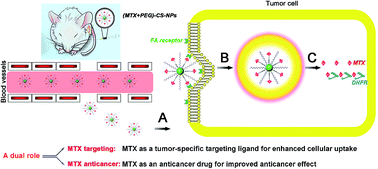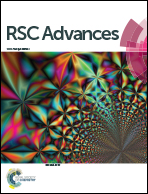Validation of a dual role of methotrexate-based chitosan nanoparticles in vivo
Abstract
A compound with a dual role has the potential to integrate its dual functions into a single nanoscale drug delivery system. Here, based on the methotrexate (MTX)-based PEGylated chitosan (CS) nanoparticles, we validated this dual role in vivo and explored the in vivo efficiency of MTX as an early-phase tumor-targeting ligand and also as a late-phase anticancer drug. Following intravenous administration, compared with the (FA + PEG)–CS–NPs and PEG–CS–NPs, the (MTX + PEG)–CS–NPs exhibited a slower blood clearance profile, longer systemic circulation time, and significantly greater tumor accumulation. Furthermore, with the aide of folate (FA) receptor-mediated endocytosis (ability to turn cellular uptake “off” in normal cells, whereas it is “on” in cancer cells) and pH/intracellular protease-mediated hydrolyzing peptide bonds (able to turn drug release “off” in systemic circulation whereas it is “on” inside endo/lysosomes), the (MTX + PEG)–CS–NPs showed remarkably superior therapeutic efficiency compared to the commercially available MTX. More importantly, this work would stimulate interest in the use of the clinically useful MTX as a synergistically self-targeted therapeutic agent in the design of a highly convergent, flexible and simplified nanoscale drug delivery system for simultaneously targeting and treating FA receptor-overexpressing tumors.


 Please wait while we load your content...
Please wait while we load your content...